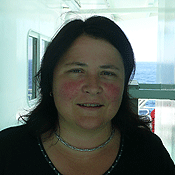A windy day.
02.08.2008 Moderate gale and sometimes gust of wind up to 22 mps. G.O. Sars is a big and rugged boat, but the big waves create challenges for several on board. Not everybody are used to the heavy sea, and several pale faces are observed in the corridores. The researchers use the day to sum up, mark and register all the samples they have collected till now.
Main content
Text and photo:Hans-Tore Larsen and Anne Grethe Tungesvik
There were taking some samples this morning despite the windy weather, but the ROV will not be used before the weather has calmed, due to the weather report we have to wait until Monday or Tuesday. It's a complex group of researchers on board, they have their own goals and reasons to participate on this cruise, but there is also a common main purpose; to show occurrence of methane gas. And this they also do, but they continue searching for at bigger source. The microbiologists are among other things, interested in the substance of the bacteria living in the sediments. On shore, we know that all nourishment the primary producers need, are made by the energy of the sun light, known as the photosynthesis. On 700 meters dept, this process is impossible because the lack of daylight. The organisms living down here, have to use another type of energy to get nourishment, this can be methane gas.
For us teachers this is also a quite easy day. We used the opportunity to have a talk with one of the microbiologists on this cruise, Ida Helene Steen.
Ida Helene Steen is born in Haugesund, she is microbiologist and participant on G.O. Sars-cruise for the first time. We have asked her for a presentation of herself and the reason for her participation on this cruise. She grew up with parents who gave a high priority to education, so it became naturally for her to start her studies. It never became a question if she was going to study, but rather where. She had already made her choice of field; she wanted to start studying aquaculture/marinebiology, subjects which wore current in the 80's and 90's.
Partly guided by her promising soccer-career, and partly by her mother's device, she applied to the University of Bergen in 1985. Here she starts studying cell-biology. She was interested in biochemistry, and started her main subject in microbiology in 1991. She joined her doctorate in '93, where her work was about molecule adaption of proteins at high temperatures. Thereafter Ida was assigned and accomplished 2 postdoc-projects, through these projects she worked two periods abroad, a half year at the University of Bath, England and later, a half year at Karolinske Institutt in Stockholm. Now, she is working at the Centre for Geobiology where she is the responsible for the laboratory of geomicrology. During this cruise, her tasks are, together with William and Frida-Lise to prepare tests and study the microbiologic life in the sediments. She is especially interested in the microorganism's functions in a life unaffected by sunlight, and how the geochemistry influences the daily life on the seafloor. They will also have the opportunity to take samples from different seafloor areas, and to compare these. Ida also mentions the possibility to compare different environments which contain methane gas and to study the microorganisms that exists here.
Ida is humble even though her profession is small and have a great respect in Norway, she points out that there are considerable and important researching at this field internationally. But it's only we who have direct access to the areas at Norwegian sector. This gives us ability to visit large and exciting areas which can give us even more knowledge of marine geobiologic research.
Maybe that's the reason she is engaged by relations between primary school and researchers, she whish that more of her profession knowledge could be more available for teachers and pupils, both through education and practical trials.
Maybe that can make researcher-juniors around in primary school in Norway, and in some years have microbiologists that grown their interest for the field already during the primary school.
